
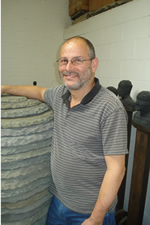

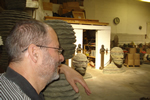
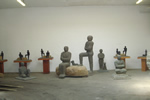
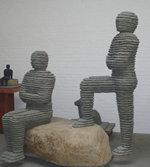
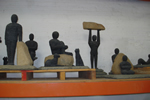
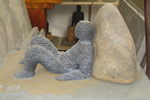
|
 |
 Boaz, our New Yorker of the Month, May 2008
Ask a New Yorker: Boaz, how did this idea for your style of sculpting come to you?
Boaz: It is very simple actually. The way I came up with my style was a process.
I came to New York in 1975. I moved to Soho. I had a loft in Soho. As I started
working, one thing for me that was always important before I came to New York
is that I always explored the primal connections of man to nature. So coming
to the New York’s urban environment, where do you find it? In Soho in
my loft I started working and exploring, ‘where do I find it?’ Then
I recognized that New York as urban of an environment that it is, it is actually
as natural an environment of any other environment on the earth. This is my
attitude to it. It comes from the point of view of realizing when I observe
a bird colony that are on top of one another and there fighting there are no
spaces between the nest. Nobody said it was unnatural or it is not a natural
environment. Urban environments are the natural habitat of humans. And we as
humans are part of that environment and a part of nature as any other creature
on earth. So with that attitude I start working and I start feeling much more
comfortable in the city.
And as I recognized the immediate environment that I was living in I recognized
that they replace all the sidewalks in the city. The old sidewalks use to be
blue stone and so I had free materials. So I picked all those blue stone materials
and started working with it. And as I started doing the work I worked with cedar
poles that they used to support trees in the streets. So I started doing construction
with cedar poles and blue stone. To come to where I am right now working with
blue stone I recognized that the way the blue stone is quarried is by the separation
of the natural formation of the rock. So they are splitting the stone in the
natural formation of it. The stone is sediments. After a millions of years of
pressure it was stratified to stone. Working with it I realized it is a very
difficult material to work with. So the only way I can work with it is if I
say to myself, ’What can I do with the materials instead of doing with
the materials that I want.’ I start to develop a dialogue with the material
and the result is the inspiration of the understanding of how stone is forged
in nature and using it in my own work. The layering of my work is such that
basically what I do is take a layer that was formed in nature, that was quarried
by humans to create floral under the feet and I use slate that is the same formation
that creates roofs over the head. It is the primal needs of shelter. As I started
working with it, I said, ‘Oh a figure how can I work with it?’ So
I carved layer by layer, then it suddenly clicked that as with humans we are
also formed by layers of understanding, layers of growth. It was very natural
for me. So what happened I worked with it? Now even when I finish a figure it
has to be stuck on top of each other where gravity is the main force of holding
it together. So they have to be free standing only by gravity before I glue
them and bolt them together. There is a great respect to nature and a great
inspiration from nature that brought the style of my work.
Ask a New Yorker: Very simple? Do you name your pieces?
Boaz: Yes. The name of pieces is really to identify them. It is basically the
same as your name when you were born. For many years I named my pieces based
on friends and family that visited me. I would name a piece after my cousin,
my friend, my uncle. Then I realized that everybody was asking me why I name
all my pieces biblical. I didn’t realize it but they are biblical names
because my personal association with names is Hebrew names. So, I decided to
be true to that and now I’m using old testaments as the source for names
for my pieces.
Ask a New Yorker: With your creative DNA, were your father or mother artists?
Boaz: No. My father was a farmer. I grew up on a small farm in Israel. I grew
up with a tremendous amount of love to the mother earth. My parents worked the
land with great love. So for me the earth is the mother earth and that is what
inspires me to be an artist. The other reason for my creativeness is that I
am totally dyslexic. So I had to find a way to express myself. I decided to
be a sculpture very young, somewhere between 12 -14 years old. By 14 I was very
serious about it already.
Ask a New Yorker: Do you have hobbies outside the studio?
Boaz: My life is my family, my wife and my children and my artwork. That is
what my life is all about. I feel as though I am very, very lucky and blessed
person because I make a wonderful living with what I love to do. So I am just
grateful.
Ask a New Yorker: What advice would you give to a young artist or any artist
for that matter?
Boaz: My advice is very simple. If you are born to be an artist and are on this
earth for that reason then you have to pursue it. The guarantee is that you
will be poor all your life. If you still want to persue it in knowing that,
if you can explore yourself and find yourself you will absolutely will a unique
artist. Each person on this earth is such a unique creature that when one finds
themselves there is no other way but by being unique. The problem with our society
is that we all like to be like someone else instead of being ourselves.
Ask a New Yorker: So your definition of success is:
Boaz: It is the ability to explore and grow as a person. I have the luxury that
I am also financially successful. But that is not what success is about. It
is to be able to continue to grow and explore. And if you find yourself and
you follow your inner soul you can’t be wrong. You can only be successful.
That is what success is, to find you.
Boaz's studio is in Williamsburg, Brooklyn on Berry St. See http://www.vaadia.com/
Original article appeared here.
|